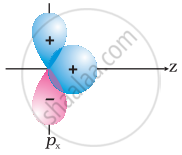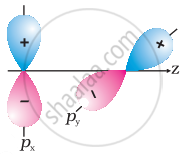Advertisements
Advertisements
प्रश्न
Give a reason for carbon is tetravalent in nature.
उत्तर
The electronic configuration of carbon is:
1s2 2s2
One electron from ‘2s’ orbital is promoted to the empty ‘2p’ orbital.
Thus, in an excited state, carbon has four half-filled orbitals.
C =
| 1s | 2s | 2p | ||
| ↑↓ | ↑ | ↑ | ↑ | ↑ |
Hence, carbon can form 4 bonds and is tetravalent in nature.
APPEARS IN
संबंधित प्रश्न
Draw an orbital diagram of Fluorine molecule
Display electron distribution around the oxygen atom in the water molecule and state the shape of the molecule, also write the H-O-H bond angle.
Give reasons for need of Hybridization
Explain geometry of methane molecule on the basis of Hybridization.
Identify the type of overlap present in H-F molecule. Explain diagrammatically.
Give the type of overlap by which the pi (π) bond is formed.
Mention the steps involved in Hybridization.
Which one of the following is the likely bond angles of sulphur tetrafluoride molecule?
According to Valence bond theory, a bond between two atoms is formed when ______.
In ClF3, NF3 and BF3 molecules the chlorine, nitrogen and boron atoms are ______.
Which of these represents the correct order of their increasing bond order.
The correct order of O – O bond length in hydrogen peroxide, ozone and oxygen is
XeF2 is isostructural with ______.
Define σ – bond.
Which bond is stronger σ or π? Why?
Considering x-axis as the molecular axis which out of the following will form a sigma bond.
2px and 2py
Considering x-axis as the molecular axis which out of the following will form a sigma bond.
2px and 2pz
Considering x-axis as the molecular axis which out of the following will form a sigma bond.
1s and 2pz
Which of the following is correct decreasing order of the repulsive Interaction of electron pairs in a molecule?
The number of sigma bonds in paracetamol is ____________.
The overlap of orbitals involved in the formation of C - Br bond in vinyl bromide is ______.
Why does type of overlap given in the following figure not result in bond formation?
 |
 |
The
